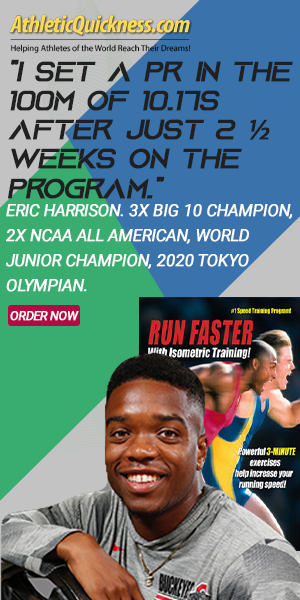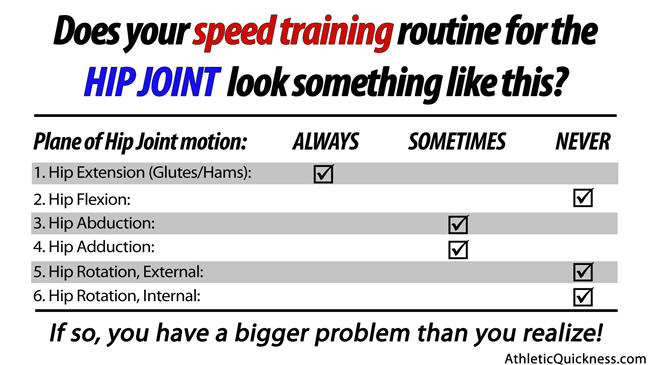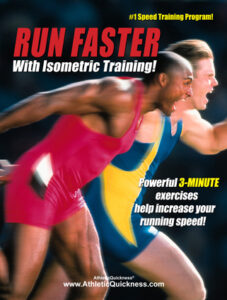Even Professionals are Clueless and Wasting Their Time
Okay, listen up athletes, coaches, trainers, professionals, amateurs, etc., I’ve got some groundbreaking information that I am going to share with you here today, information that can only be found at AthleticQuickness.com.
This information is going to help you take your athletic performance to the very next level and possibly beyond. And I can say that with absolute confidence because what I am going to share with you here today has not been taught by anybody at any level.
And I have been in touch with a lot of professional trainers and athletes in different sports over the years and every time I speak to them about the information I am about to share with you, they all get really quiet and draw a blank-face.
They get so genuinely ticked off at themselves for never even thinking about this information, but also in a sense, shocked that they have never came across this information before. But once they understood and started to implement this information they were absolutely amazed and have actually improved their performances as well as their athletes, all within just a few short weeks.
And when I talk about athletes, this also includes professionals who have been training for years in all of the best state of the art facilities you can imagine. These athletes have access to the best information and training money can buy but yet they still have not come across this information that I am about to share with you, today, for free, so you don’t have to make the same mistakes and waste your valuable time that these other athletes are making.
So, if you’re ready, listen to what I have to say. This is going to help you train smarter and improve your sports performance dramatically.
The Hip Joint is the Focal Point of your Speed and Strength
What I want to talk to you about today is your hip joint. You’ve got two of them on each side of your body and these hip joints are the most powerful joints in your body when it comes to sports, but also really in life as well.
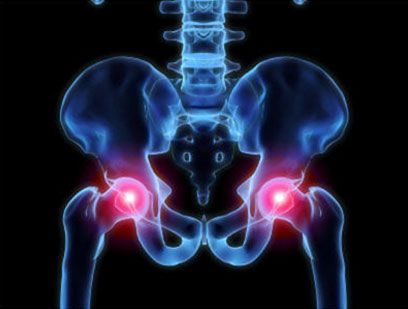
Your hip joint is so important that it is the focal point of all of your core strength and power and it initiates a lot of your athletic movements. Once your body starts to move during an athletic activity such as running, jumping sprinting, kicking, chasing a tennis ball across the court, or chasing after a football runner etc., your hip joint continues to move throughout multiple planes of motion, so you need to train it in every plane of motion that it could possibly go.
But again, what I am going to teach you right now has never been even acknowledged by the top professionals in every major sport, but once they start to implement this information regarding their hip joint, their performance in their athletes absolutely skyrockets.
So, the first think I want to talk to you about again is your hip joint but more specifically, I want to talk to you about the different planes of motion that your hip joint is capable of undergoing.
Now your hip joint is a ball and socket joint first of all and what that basically means is that can move within a spherical plane, or circular path, much like your shoulder joint. Those are the ball and socket joints of the body.
And your hip joint needs this flexibility to be able to get you to move in many different directions, cut on a dime, change directions when needed, and turn and reposition yourself. It is also needed to kick the legs and is used extensively while jumping so it has to be flexible enough to provide for these types of movements.
The Hip Joint has 6 Planes of Motion
But it also needs to be strong enough in all of these different planes to give you the extra speed and power necessary to out play your opponent. So your hip joint really needs to be trained effectively in not just one or two planes of motion, but in all 6 planes of motion if you ever hope to be successful.
So with that, let me define what these 6 planes of hip motion are. They are flexion, extension, abduction, adduction, internal rotation and external rotation.
So first things first, I bet right now your are probably thinking to yourself, “yes, I’ve heard of hip flexion and hip extension, and yes, I’ve heard of hip abduction and hip adduction, but I’m not so sure I understand what internal hip rotation and external hip rotation is.”
Well, we’re going to get to that and that’s part of your growth process here so that you can actually learn about these different planes of hip motion and then try to find exercises that are going to help you improve the strength and speed of contraction within these planes, again, to give you the advantage on the field.
But let’s talk about some of the things you do know first. Let’s talk about your hip extensors. Now that’s kind of a funny word or phrase to use because sometimes people have a hard time understanding what hip extension is, so let’s clarify that even more.
This applies to all planes of motion, not just hip extension. Now when we talk about the hip, what we are really talking about is your thigh moving at the hip joint. So, if you can picture what your thigh is doing, whether it’s going forward or backward, or side by side, that’s the same thing as saying that your hip is going forward or backward, or side by side, respectively. So, when we are talking about hip extension, we are talking about the thigh moving backward.
You are Training Just 1 of the 6 Hip Motions Repeatedly and Ignoring the Rest
And for a lot of you people reading this, I am going to go out on a limb and say, everybody reading this, you already know how to train your hip extensors very well. And you are training your hip extensors, or thigh extensors, with exercises such as the leg presses and squats. You are also training them with exercises such as lunges and deadlifts.
Now your hip extensors are your gluteal muscles and hamstrings. And you are already doing exercises in the gym to train them. And the reason why I can say with confidence is because gyms are ideal training facilities where you actually learn to train your hips for hip extension because most of the equipment is geared for that.
[sc name=”2step-optin”]
Other exercises you might do in the gym are box jumps as well as Olympic lifts that are making their way into the speed training world and that would include your power cleans and clean/pulls. These exercises require you to bend forward to grab the bar from the ground and by doing this you are putting your hip into flexion first, but when you stand up you have to extend the hip to bring it back to its neutral position.
So again, these are all designed to develop the back side of your hips. And that’s why you see a lot of top level collegiate and Olympic sprinters, they have really well developed glutes and buttocks and that’s because those hip extensors get so much attention in the gym because again, it is very easy to target these muscles when you’re there.
Two Additional Planes of Motion That Need Attention
The other muscles I want to talk about here are muscles that you are already familiar with and those are you hip abductors and hip adductors, or, in other words, your thigh adductors and thigh abductors. So when we talk about thigh or hip abduction, we are talking about separating your thighs apart from each other. And when we are talking about hip or thigh adduction we are talking about crossing one leg over another or bringing both legs in toward each other.

So again, I say with confidence that you are already aware of what these muscles and hip planes of motion (extension, abduction, adduction) are about because you have been exposed to the machines that train these muscles that are available in most gyms. Because the gym equipment guides you through these motions and so you already know about them.
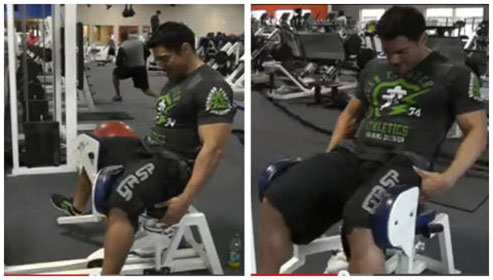
So these first three planes of hip motion (extension, abduction, and adduction), and again there are six, you likely already have some good working knowledge of them and even if you aren’t currently doing, say, adductor or abductor work, you at least know how to train them if you decide to.
3 More Hip Motions Are Going Untrained – One of Which Could Double Your Running Effeciency And Catapult You to New Levels of Performance
And this is where most training at the high school, college, and yes, even the professional football, basketball and baseball level as well as even the Olympic sprinter level, this is where, with regards to the hip joint, most athletes training stops.
And that is a big, big problem. And that is because there are three other planes of motion (hip flexion, internal hip rotation, and external hip rotation) that get completely ignored in your training routine. And my guess is that if you’re reading this you too, have never once trained these other three planes of motion effectively, if at all. And we will talk about them shortly.
And I want to emphasize that you would think these higher level athletes, who put in hours and hours in the gym or out on the track or field, you would think their training would be so far advanced because they have reached such a high level, but realistically not much has evolved from what they first learned in the gym at the high school level.
But believe it or not, they carry these same habits throughout their entire athletic careers. But overall, their habits fall so far short of a complete hip workout and are actually terrible because they ignore the other 3 planes of hip motion.
And again, these are professional athletes, superbowl champion athletes, all pro athletes, hall of fame athletes, Olympic athletes, that are stuck in training for what you might call the ‘drive’ phase of running only, and this is the pushing phase through one side of the pelvis by the leg that is on the ground.
But if you think about running, and we are going to talk about hip flexion next, and tie this all together, running is a push with one leg that is on the ground, but it is also a high and fast knee thrust with the other leg through the opposite hip that helps your stride and turnover rate.
So it’s a hip or thigh thrust with the other leg that comes off the ground. But If those hip flexors in front, which are responsible for this knee thrust through the hip, if those are weak, you are really only working at 50% efficiency with regards to the amount of thrust that is capable of being produced across your pelvis when you run.

Now if some other athlete you are competing with has well developed hip flexors who has already come across this information and are generating 100% thrust across their pelvis and hips, and I know they are out there, if you have to compete against them, you are going to be at such a disadvantage because they will be able to move a lot quicker and faster than you.
This is not so much because of genetics as you might think, though it plays some role, but more so because most athletes simply ignore their thigh flexors in their training routine.
Under Developed Hip Flexors are Slowing You Down
When you overlook your hip or thigh flexors, you are putting yourself in such a compromised position whether it’s sprinting past your opponent on the field or track, or even if it’s trying to make great catch in the outfield or chase a receiver down the field, or any other sport skill that depends on running speed…if you don’t have these muscles developed like your competitor does in this area, you’re going to lose out 9 times out of 10. And that is something that should never happen because it is easier to fix than you could imagine.
But, what many athletes usually think of when you talk about training your hip flexors is, “What’s the big deal with training them? The leg is off the ground, there’s no resistance on that leg, etc.”
But the power to run faster comes from thrusting through both hips at the same time, but, you’re only training to thrust or push through one of them at a time.
This is because the opposite hip motion is weak due to poorly developed hip flexors and so if you’re not thrusting that knee and thigh upward and forward (hip flexors) during the stride at the same time the other leg is pushing (hip extensors), if that is not equal you’re going to be out of synch and this will force yourself to shorten your stride because those weak hip flexors in front just can’t keep up with the powerful hip extensors in the back.
You Are No Better Than Your Weakest Link
And again, I tell athletes, you’re only as strong as your weakest link. And you can have the biggest, strongest and most powerfully developed hip extensors (glutes and hamstrings) but if their counterpart on the front side (hip flexors) are weak and can’t match that, they won’t be able to carry and quicky move the weight of the leg once it’s off the ground. And that’s where you will lose your race more often than not.
Those Who Think They Train Hip Flexors Are Only Getting Minimal Benefit
But most athletes, and possibly even you, will say they train their hip flexors. They will say they do sit-ups and hanging knee raises but after that you find there really isn’t much going on with their training of these muscles.
And even if they are doing a lot of these exercises, they aren’t doing them to the level that’s going to engage the hip flexors well enough to significantly strengthen them. Or they many never even engage all 7 of them.
And some of these hip flexors, like the psoas and ilacus are located in the lower lumbar spine and the front of the hip bone itself, are the only ones getting all of the exercise when you do sit-ups. And this is because doing a sit-up is pretty much like doing a reverse hip, or thigh, flexion exercise where there is only minimal leverage being applied to the front of the hip.
[sc name=”2-stepoptin-blue”]
Now you might get a little more hip leverage by doing hanging knee raises but when the knees are flexed the torque is minimized on the hip flexors so you really can’t engage them with the force you need to match up with the hip extensors.
So when athletes are doing these exercises, they are only exercising 2 of the 7 hip flexors, but equally important, they aren’t really leveraging them with the kind force they need to balance with the hip extensors.
And if you compare your current hip extensor routine/exercises (glutes and hamstrings) located on the backside, with your hip flexor routine or exercises on the front side, you will find that it’s not even close.
Your hip extensor routine will dominate your hip flexor routine. If you just go ahead and list all of the exercises side by side on a scale for each, your hip extensors exercises are going to weigh the scale down so much more in their favor and the hip flexors are going to fly upward because you’re not doing anything with those to balance the scale.

And to help drive this point home even further, I want you to think about this little analogy: if you have ever gone to a restaurant you will see that the door into the kitchen opens in and out, in both directions, but it always ends up in the center, or closed position.
And the reason why it ends up in the center or closed position is because it has a spring on both sides that is equally tensed. So no matter which way the door goes, it’s always going to balance itself out and end up right back in the center. That’s what you, as an athlete, need to establish within your hip joints.
But right now, my guess is, my belief is, the backside of your hip muscles are very well developed, or at least, more developed than the front side (hip flexors). And if you compare those hip extensors to a spring, they would be like a garage door spring.
Compare the Size Of Springs on a Garage Door to An Ink Pen Spring If you have ever seen a garage door spring, they usually have two springs located on either side of the center point. And those springs are probably about 3 inches thick, 4 feet long… they look like big menacing torqued down springs that have to lift a garage door that could weigh a few hundred pounds. That’s what you have on the back side of your hips in your glutes and hamstrings.
On the front side, you don’t have that. You’ve got something equivalent to the spring that you might find in an ink pen where you click the little button at the top of it to expose the ink cartridge. You have a small “ink pen spring” on the front trying to compete with a powerfully torqued “garage door spring” on the backside.
Weak Hip Flexors Facilitate Hamstring Injuries
And so what happens is, when you see athletes running down the track who have well developed hip extensors, when they pull a muscle, they usually end up pulling their hamstrings. And that’s because their hamstrings are firing so hard but the front side of the opposite leg where the hip flexors are, those are much weaker so they shut down way too soon to prevent injury to themselves. But those hamstrings keep driving and driving the athlete until they basically burn up.
And if you watch these athletes, more often than not, when they pull up in the middle of a 100m race, they grab the back of their leg and never the front. In fact, they grab the back of their leg high up near their butt. They don’t grab behind their knee, they grab up high behind their butt because those are the origins of the hamstrings. The whole system is out of balance and too strong for its own good.
So again, it’s a very big deal when you forget to train your hip flexors, if nothing more, to prevent injury. But the real upside to training your hip flexors in that it will increase your stride length, your turnover rate and greatly increase you running speed.
Plus stronger hip flexors in front will balance out your powerful hip extensors in the rear allowing your nervous system to shift your muscles and mechanics into overdrive and propel yourself forward like you turned on an afterburner jet engine, as your nervous system is no longer concerned with protecting yourself from an out of balanced cycle rotating at high speed.
The AthleticQuickness.com training programs are phenomenal for training, not just two of your hip flexors, and not just four of your hip flexors, but all 7 of your hip flexors and getting you new levels of running speed and kicking power.
And again, if you have seen any of our videos, whether it’s from the website www.HowToRunAFaster40.com, or www.SpeedTrainingChallenge.com, or even www.SoccerTrainingChallenge.com, this is the exercise that we feature in those videos.
That’s because it is able to apply such an incredible amount of torque and leverage on the front side of your body that the first time you do this exercise you might cramp up and have to stop it midway through it because again, you have never trained these muscles before.
And again, go back into your gym experience, what have you done recently to train the front of your hip where your hip flexors are? And when we talk about the hip flexors, these are really long muscles. People think that they are tiny little muscles…those are the hip rotator muscles, the external and internal rotators primarily that we will talk about next.

Hip Flexors are the Longest Muscle Group in the Body.
But your hip flexors, these muscles are about 3 feet long. They are the longest muscle group in the body. They begin in your lower back, really at the last level of the 12th thoracic vertebrae and then the attach below your knee.

So if you measure below your knee to about a third of the way up your back, you’re talking about 2½ to 3 feet of combined muscle length on the average person. And that’s what these hip flexors do. We’re not talking about your quadriceps around the knee, that’s a totally different story. We are talking about the leverage and muscles around the front of the hip joint, kind of where the opening to where you front pants pocket would be…that would be the midway point of these hip flexors.
And again, those hip flexors are what have to balance the powerful hip extensors, and hopefully by now you are probably thinking, “There’s no way near those two muscle groups are balanced on my body.” So, that’s what you have to do…balance them out!
Even NFL Pros Are Still In The Dark
Now I want to share something else with you here. I got to spend some time at a top level NFL speed training facility in Boca Raton, Florida. I won’t mention any names here, but if I did, you would surely recognize them.
One of these former athletes is a broadcaster on ESPN, who is also a hall of famer. Some of these athletes have already won superbowl rings, others are all pro defensive backs. And so the trainer there who trains these athletes and many more just like them, who I shared this information with as well as the training techniques for the hip flexors, he had never heard of any of this information that I just told you about the hip flexors.
He thought these muscles were small and tiny, and basically irrelevant. He is not alone in this improper assessment of these muscles. He had no idea their combined length was close to 3 feet long. And not surprisingly, when I had him do the hip flexor exercise seen in the videos, he actually cramped up after 5 or 6 seconds in to the exercise after he had just hammered away at the hip extensors for over an hour. Needless to say, he wasn’t too happy with himself.
But this guy is training top level elite athletes and he is now convinced that this information is going to take his training and his athletes to the next level. And to give you an idea of who he is, every athlete has an agent. And it’s a big deal for a college athlete looking to turn pro to get drafted very high. So, if you drop a couple of draft places you lose money. So these agents send this trainer their athletes to help get the 40 yard dash time lowered.
Because the 40 yard dash, if you don’t already know, is the #1 thing per position, that scouts and coaches are looking at. So, if you don’t match up with other people at your position or with the position you have to play against with your 40 yard dash time, there going to figure, you’re going to get beat all the time and so they can’t use you.
So these agents are willing to pay this guy, this trainer I trained, thousands of dollars to get even a 1/10 of a second off their 40 time. And I know now that this trainer is going to be able to deliver these results even better than what he has already been able to do now that he knows this information that I just shared with you.
So, that’s all we’re going to talk about for now regarding the hip flexors. Again, you can go to those websites I listed earlier to try this exercise. It looks very easy but I tell you what, that hip flexor exercise is probably the hardest thing you’ve ever done so far primarily because you have muscles sitting their dormant, on the front side of your hips and they are just waiting for you to come along and challenge them with activity and they are just going to jump alive when you start doing this. And athletes typically start to see results within 5-7 days. My expectation is the same for you too.
Hip Rotators Are Also Totally Ignored
Let’s talk now about the external hip rotators and internal hip rotators. So let me ask you this…first of all, do you even know what those are? Because some people might have been thinking up until now, “Aren’t those the same as the hip abductors and hip adductors?” Well now, that’s not exactly the case, is it?
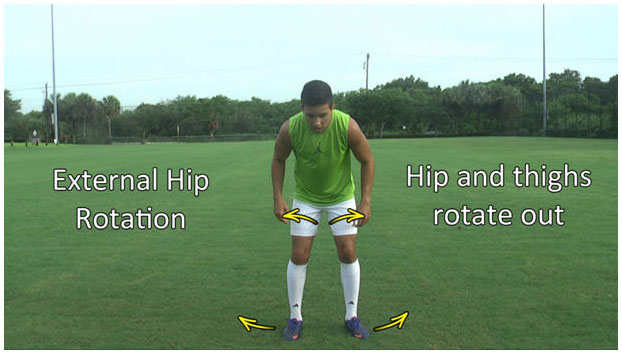
When we talk about hip external rotation, we are talking about when your feet or toes point outward. So, you kind of walk maybe like a duck. But it’s not your foot turning out by itself rather, your whole lower leg and thigh is turning outward at the hip joint. Now there are 8 external hip rotator muscles located in the back of your buttocks probably where your pants pockets are.
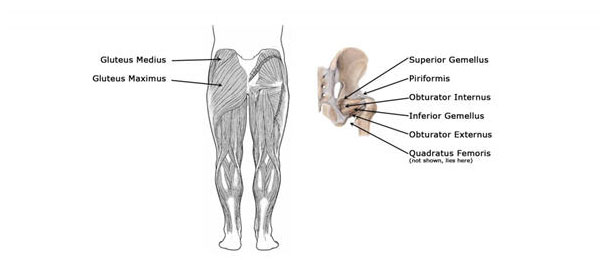
These 8 muscles are the gluteus maximus, which is also a hip extensor but a lot of these muscles have more than one function, and that’s by design for continuity with movement. You also have the gluteus medius posterior fibers. There are anterior and posterior fibers of the gluteus medius. The anterior fibers are internal hip rotators and the posterior fibers are the external rotator fibers.
The posterior fibers help pull the hip and thigh around the back to externally rotate the hip so the feet can flare outward. And then you have six other little muscles called the piriformis, obturator internus, obturator externus, inferior gemellus, superior gemellus and quadratus femoris, not the rectus femoris, that’s a muscle in the front. The quadratus femoris is a little square shaped muscle in the back of the buttocks located deep within that hip joint.
Strong Hip Rotators Improve Change of Direction Speed
So all these muscles, when they contract, they pull and rotate the femur bone or thigh bone, outward around to the back so your feet can flare. And so the reason why I am talking about these muscles is because they are necessary for your change of direction speed…both the external and internal hip rotators.
And let me quickly tell you what the internal hip rotators are: those are the anterior fibers of the gluteus medius, the gluteus minimus and your tensor fascia lata.
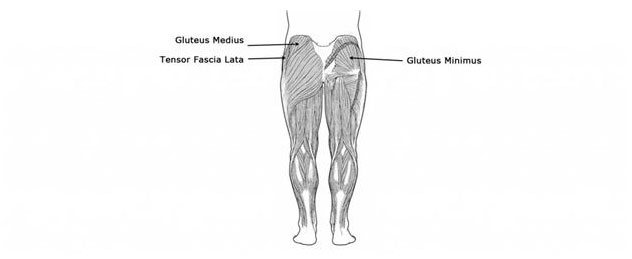
These muscles will help make you pigeon toed. So being pigeon toed means your toes are pointing in toward each other and you walk like a pigeon, that’s an internal hip rotator problem if your muscles are too tight, and some people actually have that.
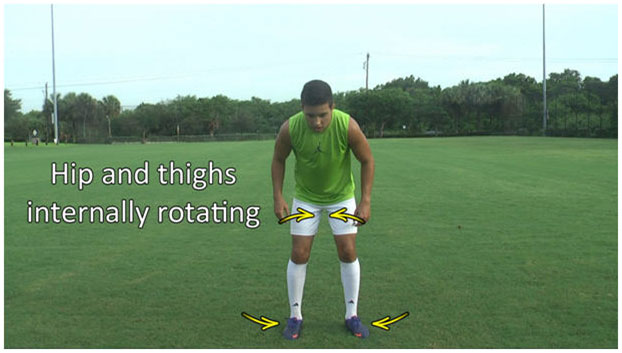
And again, if your external hip rotators are too tight, you more or less walk like a duck where your toes flare out.
But every athlete needs these muscles to be strong in the hip because your hip joint initiates all of your movement especially while running and kicking…they need to be able to turn that hip quickly.
And how many times do you hear during football season where a cornerback has difficulty changing their direction of speed quickly and keeps getting beat in pass coverage? And that is all driven by both internal and external hip rotation.
And the reason these athletes are slow in this movement, and perhaps the same applies to you, is because athletes simply do not know how to train for it.
But guess what? Neither do most professional athletes and trainers! And yes, I did share this information with one of the top NFL trainers as well as a Superbowl Champion Strength Coach for the New Orleans Saints! I am still amazed why no one has ever taught this information before…it seems so fundamental to sports!
Hip Rotators and Hip Flexors Give You Kicking Power and Change of Direction Speed

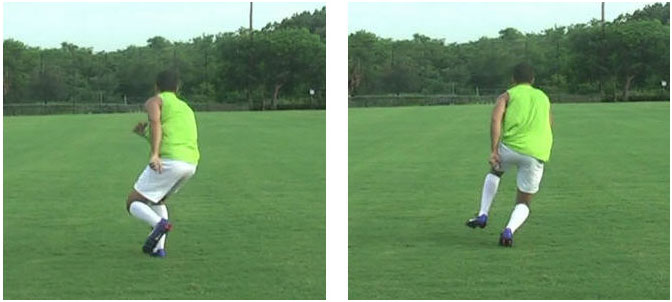
There is No Gym Equipment for External and Internal Hip Rotation
But, maybe this is why: Have you ever seen any piece of gym equipment that exercises your muscles for hip internal and hip external rotation? And I already know the answer is “no”, and the reason why I know this is because I know firsthand that since trainers at the highest level have never seen or heard of these muscles, then they certainly have never seen or heard of gym equipment that trains them, so the same likely applies to you.
But the reason this is important is because there are 6 planes of motion for the hip joint and you are really only training one of them hard…the hip extensors (glutes and hamstrings).
You may be touching the abductors and adductors very little if at all, but I know for a fact that you are not even touching the internal and external hip rotators. And with regards to the hip flexors, even if you are doing anything for them as well, you are likely only training 2 of the 7 of these muscles.
Why Traditional Training Routines Can Make You Slower
So, the bottom line is you are really only focusing on 1 of the 6 planes of hip motion and that’s not good. But yet you keep going back in to the gym and keep hammering and hammering and guess what?…your speed and quickness does not improve. You get frustrated and I will tell you what… you might even be getting slower.
And I’ve said this in the past, and people would have a lot of problems when I would say this, but this is why you could get slower…you’re getting too heavy on the backside. And that’s great when your legs are on the ground pushing in the drive phase, but when that leg comes off the ground during the stride, all that weight on the backside becomes dead weight that has to be carried by the muscles on the front side of your hips, the sides of the hips…the muscles that you are never training. So you look like you are running with bricks in your pants…or what some may say…stuck in first gear!
And so now you’ve got this dead weight to carry around and you can be as strong as you want, but if that is not balanced around the entire hip joint, you can actually get slower because you now have too much extra weight in areas that don’t allow you to function properly.
[sc name=”2step-optin”]
So, this is the information that I shared with the top level trainers. I’ve also shared this information with some hall of fame players who have reached me in my office who were looking for ways to help their sons and daughters get faster. We get contacted all the time by college athletes looking for the extra edge and we get our occasional request from an agent.
But the bottom line is this: nobody is going to share this information with you other than athleticquickness.com. Your opponent that you play against every week isn’t going to come up to you and say…”Hey, guess what I learned? I learned how to run faster and let me show you what I am doing.” That is never going to happen in a million years.
And this really blows my mind to; when I see the testimonials come in to our site, I am very thankful for each and every one of them. I don’t care if it’s an 8 year old or a 58 year old. When we get them I am so happy to get them and I encourage people to please let me know how you’re doing. But I am also amazed too, that some of the more competitive athletes, who maybe have a contract or starting position on the line, when they share their results.
I am very thankful to them and it is very admirable because again, think about it, you’re competing for a job, you’re competing for a contract, and it’s probably not the best thing to tell someone else what your secret is.
Because I guarantee you, they’re not telling you what theirs is. They may already be doing the same thing that you are telling them about but they are not going to agree and say, “yeah, I’m doing that too.” They are going to try and keep you in the dark as much as possible.
So the next time you go in to the gym, ask your personal trainer, ask your coach, “hey coach, we are hammering these hip extensors, the glutes and hams, but I just found out there are 5 other hip planes of motion, and we may be doing some abductors and adductors, but teach me something with internal hip rotation and external hip rotation. Or teach me how to train all 7 of my hip flexor muscles, not just the two of them.”
And I guarantee you, that if you have a good coach, hopefully if they don’t know, they will tell you that they don’t know and then tell you, “hey, let’s research this and find out about this as much as we can because you just brought some information to me that I have never heard before!”
And I will guarantee you that your whole team will be better off for it. You will be a lot more competitive and your training is going to be a lot more fun because again, it’s not going to be the ‘same old, same old’ every time you get into the gym…squats, deadlifts, lunges, box jumps, even running down the field with a parachute or weight sled etc. And again, I love all of those exercises, those are great, but they are not going to change anything for you if you don’t engage the other 5 planes of hip motion appropriately.
But yet, our AthleticQuickness training programs do. So depending on what you are looking for, especially if you are not only a runner, but a kicker too, whether it’s a punter, placekicker, or even if you practice martial arts and you do a lot of kicking, the soccer program of ours has not only the exercises for the hip flexors, hip extensors, abductors and adductors, but that’s the program that has the internal and external hip rotation exercises. So that is the most complete hip joint training program that we have.
The run faster program is equally great because we do give the information on the internal and external hip rotation exercises as a bonus for people who buy this, so you do get all of that, it is just not contained within the immediate contents of the written program. But you do get the videos for that. We also show you how to do some modifications to these exercises so your training never gets stale and you’re constantly looking for ways to gain improvements.
Because again, you’re going to improve very fast, within 5-7 days, but we don’t want you to just stop there, we want you to continue to use the program just like a lot of the professional athletes are currently doing.
So, if you have any questions, please, write to us, leave us a comment. I look forward to hearing from you and I will continue to share more of this ground breaking information with you as I get it. But for right now, you are light years ahead of your competition and take what I have given you and learn to apply it.
[sc name=”soccer testimonial banner – green”]
[sc name=”Order Here Button-01″]

